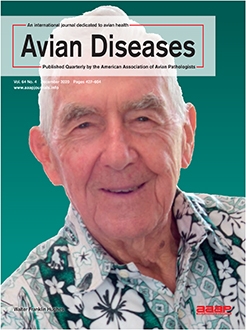In the spring of 2019, adult (75 wk old) brown laying hens from a commercial, pen-free, egg-laying facility (11,000 birds per house) located in northwest Arkansas were obtained for the purposes of sourcing robust and evenly dispersed cestode infections for anticipated anthelmintic evaluations. To that end, four birds from each of six discrete sites (northwest, northcentral, northeast, southwest, southcentral, and southeast) in one production barn were obtained on two occasions, 8 days apart, and necropsied for helminth counts. A definite, repeated, location-to-location variation in infection incidence and magnitude was seen for each of the two cestode parasite species present and for one of the two nematode parasite species present. Burdens of Ascaridia galli were generally similar regardless of bird location, with site-specific mean totals per bird over both sampling days between 31 and 80. For the remaining helminths, infections were greatest for birds from the southern half of the building as opposed to the northern and from the western end of the barn as opposed to the central or eastern portions. Location-specific mean worm burdens over both sample dates ranged from 340 to 1133 (Heterakis gallinarum), 14 to 277 (Raillietina cesticillus), and 1 to 35 (Choanotaenia infundibulum). The greatest individual bird infections were 299 (A. galli), 3575 (H. gallinarum), 1015 (R. cesticillus), and 102 (C. infundibulum). The above counts are for all developmental stages combined (A. galli and H. gallinarum) and for scolexes only (R. cesticillus and C. infundibulum), as determined via standard collection and quantification procedures using both intestinal contents and overnight soaks. Immediately before the mapping study outlined above, birds were obtained from the east end of the source barn and used for the nematocidal evaluation of fenbendazole in the water (5 mg/kg body weight [BW] for 1 day), levamisole in the water (8 mg/kg BW for each of 2 days), herbal mixture in the feed (1 gm/4.5 kg BW each day for 5 days), diatomaceous earth (2% of total feed for 10 days), and a nutraceutical mixture feed supplement (2% of feed for 7 days). Based on arithmetic means for adult forms, control trial efficacies for A. galli and H. gallinarum were 0% and 12% for the nutraceutical feed additive, 0% and 22% for the diatomaceous earth feed additive, 0% and 26% for dietary herbals, 87% and 63% for levamisole, and 82% and 84% for fenbendazole, respectively. Only adult burdens of A. galli and H. gallinarum for fenbendazole- and levamisole-treated birds were significantly different from control bird levels (P ≤ 0.05).
How to translate text using browser tools
10 August 2020
Distribution of Four Parasitic Helminth Species in One Pen-Free, Egg-Laying Housing Facility, and the Corresponding Efficacy of Nutraceutical and Pharmaceutical Administrations
T. A. Yazwinski,
C. Tucker,
E. Wray,
R. Cauble
ACCESS THE FULL ARTICLE

Avian Diseases
Vol. 64 • No. 4
December 2020
Vol. 64 • No. 4
December 2020
helminths
nutraceutical
parasite
poultry




